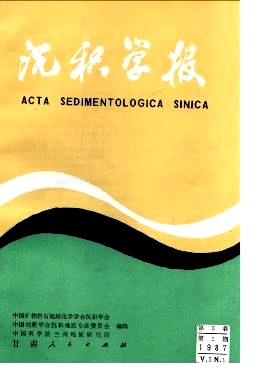STUDY OF THE RELATIONSHIP BETWEEN CHARACTERISTICS OF CLAY MINERALS AND DEPOSITIONAL ENVIRONMENTS
- Received Date: 1985-03-31
- Publish Date: 1987-03-10
Abstract: By applying the methods of understanding unknown environments from known environments and the principle of uniformitarianism("the key to the past is in the present"), the relationship between characters of clay minerals in mudstone and depo-sitional environments is discussed in this paper. Thus the possible facies indicators in clay, such as microstructures, autogenetic clay minerals and assemblage of clay minerals, have been discovered. And it was tried to use them to indicate the depositional environments of some mudstone without obvious macroscopic facies indicators. First, the samples of different mudstone,which were collected from the same area and the same coal-bearing strata and which contained various facies fossils, were taken respectively to be representatives of seawater deposit, brackish deposit and fresh-water deposit. In order to contrast, additionally, several modern mud samples were taken from different modern enviornments in the Luan River system. Then, these samples of different environments were studied in detail by scanning electron microscope, X-ray diffraction and differential thermal analysis. The results of repeated contrast showed that following three aspect characteristics of clay minerals in the samples were closely related to depositional environments, probably, they were controlled by environmental conditions: 1.Orientation and fabric feature of clay In freshwater samples, the orientation of clay particles was better, flaky clay particles tended to arrange parallelly each other and showed a kind of parallel structure. While in marine and brackish samples, flaky clay particles accumulated in a jumble and showed somewhat flocculated, honeycomb, and cardhouse structures. The former probably reflects that the deposition of clay particles in freshwater,Which was short of electrolytes, was mainly controlled by hydrodynamic condition, and the suspended clay particles deposited as single flakes. The latter probably reflects that deposition of clay in seawater or brackish water, which were rich in electrolytes and microbes, was not only controlled by hydrodynamic condition, but also strongly influenced by coagulation, organism agglutination and flocculation, the suspended clay particles tend to deposit as aggregates of clay minerals. 2.Autogenetic clay minerals The observation of SEM showed that different autogenetic clay species existed in different environment samples. In the marine and brackish deposits the main autogenetic clay min ls are illite, montmorillonite and chlorite. But in freshwater deposits mainly is kaolinite. It indicates that the formation of autogenetic clay minerals arae controlled by physicochemical condition of water medium in depositional environments. So it promises to indicate environments by studying types of autogenetic clay minerals in mudstone. In the SEM photographay the identification of autogenetic clay minerals can be summarized as follows;(a) Mineral grain is complete and its edges and corners are clearly discernible and withoat any transported marks;(b) It generally formed in the pore and fossils cavity, its crystal size and arrangement were restricted by crystal space and out of relation to terrigenous clay grain;(c) Some autogenetic clay minerals transformated from other minerals, so it could be identified according to the relation between both of them. 3.Assemblage of clay minerals By utilizing X- ray diffraction and differential thermal analysis, SEM and chemical analysis, the relative content of each type of clay minerals in each sample has been estimated. The assemblage of clay minerals in freshwater environmental samples is distinct from seawater and brackish ones, for example, in brackish clay samples the main clay assemblage is illite-montmorillonite-kaolinite (arranged in sequence of relative content),and in freshwater clay samples the main clay assemblage is kaolinite-illite-montmorillonite. The causes for different clay assemblage might be the following: (a) From slightly acid, low salinity fresh water to basic, highly salinity seaw
| Citation: | Liu Guanghua. STUDY OF THE RELATIONSHIP BETWEEN CHARACTERISTICS OF CLAY MINERALS AND DEPOSITIONAL ENVIRONMENTS[J]. Acta Sedimentologica Sinica, 1987, 5(1): 48-57. |






 DownLoad:
DownLoad: